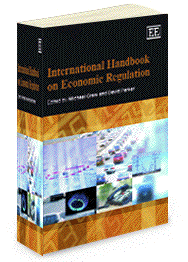
IAN SAVAGE
DEPARTMENT OF ECONOMICS
Department of Economics > Ian Savage > Economic Regulation

 Ian Savage (2006). Economic regulation of transport: principles and experience. In Michael Crew and David Parker (eds.), International Handbook on Economic Regulation. Cheltenham, UK: Edward Elgar.
Ian Savage (2006). Economic regulation of transport: principles and experience. In Michael Crew and David Parker (eds.), International Handbook on Economic Regulation. Cheltenham, UK: Edward Elgar.
[Publisher Information] [Manuscript Version]
Freight and passenger transporationt represents a large proportion of economic activity, and has a long history of economic regulation. The regulation has taken the form of both public ownership, and public regulation of private firms. The primary underlying rationale for regulation is that the substantial fixed infrastructure necessary in most modes of transportation give rise to economies of densities, and potential market power abuses inherent in a natural monopoly. In some transportation modes, especially highways, there is also concern that the second best pricing necessary to cover the infrastructure costs would lead to such a large deadweight loss that public provision through two-part tariffs (such as licence fees) is necessary.
The traditional characteristics of regulation were control of publicly-posted prices, and restrictions on entry. The effects were typically that cross-subsidies between "good" parts of the network and secondary markets were inherently encouraged, new entry did not keep pace with market expansion, and costs increased as labor and equipment suppliers shared in the rents that were earned.
Starting in the 1960s, the wisdom of existing regulations was questioned and the late 1970s and 1980s marked considerable regulatory reform. In some modes regulation was almost totally removed and competition has flourished (trucks, airlines). In other modes intermodal competition (railroads) and contestability is believed to constrain market power (secondary airline routes), and in some parts of the world Demsetz-style contracting has been used to introduce competitive pressures for the rights to be in the market rather than competition occurring in the market (urban transit, rail passenger services). However, other modes are still regarded as possessing market power (toll highway facilities, pipelines, railroad bulk commodities) and continue to be price regulated or provided by the public sector.
This paper presents the major economic models of regulation and regulatory reform in the context of their applicability to transportation, as well as reviewing the classic empirical studies on the nature and effects of regulation, and the experience of regulatory reform in different modes over the past quarter century. Examples are drawn from all parts of the world. The paper provides a "road map" showing a series of questions that a regulator should ask to decide the appropraite regulatory regime (if any) for a particular transportation mode.
© 2011 - Last Updated: 04/22/2011 - Disclaimer